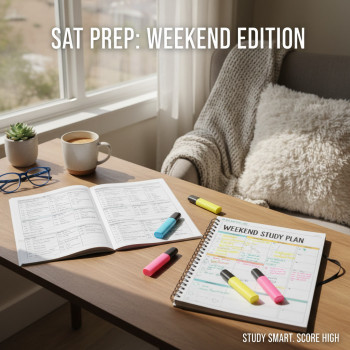Why This Feels Like a ‘Retake Moment’ in 2025
Walk into any high school guidance office, and you’ll hear the same theme: more students than ever are planning a second or third SAT attempt. That’s not a random trend or a social media fad. A mix of technical changes, clearer score-sending policies, evolving college practices, and smarter prep options has made retaking the SAT a strategic—and often worthwhile—decision in 2025.
Before we get tactical, let’s pause and consider why retakes matter. A higher SAT score can broaden your college options, increase scholarship eligibility, and give your application more balance if your GPA or course rigor raises questions. For many students, a retake is less about perfection and more about unlocking the next level of opportunity.
Key drivers behind the uptick in retakes
- The Digital SAT format: Shorter sections, a device-based experience, and digital practice tools mean students feel more confident about targeted practice and incremental gains.
- Faster feedback loops: Test-takers can often access scores and detailed skill breakdowns more quickly, so they know exactly which areas to target for a retake.
- Score Choice clarity: Policies that let you send only your best dates (with some exceptions) reduce the risk of a low score hurting your application.
- Admissions nuance: Many colleges remain test-optional, but a strong SAT score still helps in scholarship competition and when admissions officers compare academically similar applicants.
- Access to high-quality, low-cost prep: Free official practice on platforms like Khan Academy and advanced offerings such as 1-on-1 tutoring or AI-driven study tools make improvements more achievable.
How the Digital SAT Changed the Retake Calculation
If you took the SAT in the pre-digital era, picture an old-school paper test: thicker booklets, erasers, and a different timing rhythm. The Digital SAT rewired that experience—and with it, how students prepare and decide whether to retake.
Shorter test, different timing, new technique
The digital format tends to break the exam into shorter, focused modules and uses on-screen navigation. That changes time management strategies and the types of practice that matter. On a retake, you can be surgical: practice the exact item types that cost you points, rather than retreading everything.
Actionable scoring insights
Score reports now often highlight the precise skills and question types where you lost ground. That means your next study block can be high-impact: instead of guessing which algebra concept you missed, you’ll know whether to drill quadratic manipulation or function interpretation.
Top Reasons Students Decide to Retake
Deciding to retake isn’t about second-guessing yourself—it’s about strategy. Here are the most common, practical reasons students choose a retake:
- Scholarship thresholds: A few points can unlock or increase merit aid. That’s immediate ROI.
- Superscoring benefit: If a college superscores, improving one section on a new date can be enough to boost your overall composite.
- Application timing: Students who test early (spring junior year) often retake in the summer or fall to arrive at their best application score.
- Targeted weaknesses: After reviewing the score report, many students find one or two skills where deliberate practice yields quick gains.
- Reduced anxiety: Familiarity with the test day flow—especially the digital tools—can reduce errors and time-wasting decisions.
A student story: how a focused retake paid off
Imagine Maya, who scored a solid math section but stumbled on command-of-evidence reading items and a handful of grid-in problems. After analyzing her report she did focused practice—two weeks on evidence-based reading and one month on targeted math drills—then used official full-length digital practice tests to simulate test-day pacing. The result: a step up that opened doors to merit interviews and scholarship consideration. That’s how many retake stories unfold: small, deliberate changes, not frantic all-night cram sessions.
How to Decide If a Retake Is Right for You
Not every student should retake. The choice depends on goals, application timing, and the likely gain from additional preparation. Use the following checklist to make an honest, useful decision.
Retake decision checklist
- Do you have a clear, realistic target score based on the colleges you want?
- Did your score report show specific, fixable weaknesses?
- Is there enough time between now and your application deadlines to study and retake?
- Will a modest increase (5–40 points) change your scholarship or admission prospects?
- Do you have access to focused practice materials or guided tutoring to make that improvement likely?
When not to retake
Skip the retake if you’re burned out, if the score is already within a target range for your colleges, or if retaking would distract from other parts of your application (like final grades, portfolios, or application essays). Quality over quantity: a well-planned single retake often beats multiple rushed attempts.
Study Strategies That Actually Move the Needle
On retakes, efficiency wins. Here are evidence-based, practical strategies that top students use to squeeze more points out of the same number of study hours.
1. Diagnose before you study
Start with your score report. Identify the question types you missed, then map them into a study plan. If your errors are concentrated in algebraic manipulation or in data interpretation, focus there rather than re-reading content you already know.
2. Practice like it’s test day
- Use full-length, timed digital practice tests in the Bluebook or official digital formats.
- Replicate the environment: reduce distractions, stick to the exact section timing, and practice using the digital tools.
3. Targeted micro-sessions
Short, laser-focused sessions beat marathon reviews. Try 30–50 minute blocks on a single skill (e.g., main idea inference or linear equations) followed by a quick assessment to track improvement.
4. Error logs and deliberate review
Create an error log. For every missed question, write: type of question, root cause (content, careless error, timing), and a 1–2 sentence plan to fix it. Review this log weekly and watch for repeating patterns.
5. Mock pressure and pacing drills
Some students can answer the questions but lose points to pacing. Do section-only drills under strict timing. Practice triage—deciding which questions to mark and return to—so you don’t get stuck on a few items during the real test.
How Much Improvement Can You Expect? Realistic Gains
Improvement varies, but many students see their biggest jumps after the first retake, especially when they use targeted preparation. Here’s a simple reference table that shows reasonable expectations for different study investments and starting points.
| Starting Score Range (Composite) | Focused Study Time (weeks) | Realistic Score Gain | Why this is achievable |
|---|---|---|---|
| 900–1000 | 6–10 | 40–120 points | Big opportunities to fix foundational errors and content gaps |
| 1000–1200 | 4–8 | 30–80 points | Targeted skill work and pacing improvements are high-yield |
| 1200–1400 | 3–6 | 20–60 points | Fine-tuning difficulty-level questions and timing pays off |
| 1400+ | 2–4 | 10–40 points | Marginal gains through error reduction and strategic guessing |
Remember: these ranges are general guidance. Individual results depend on the quality of practice, starting knowledge, and test-day conditions.
Study Plans for Different Timelines
Your study plan should match how much time you realistically have before a test date. Below are three sample plans that have worked for many students—each built on focused practice and practical milestones.
Six-week sprint (fast, focused)
- Week 1: Full diagnostic digital test + error log creation.
- Weeks 2–4: Daily micro-sessions focusing on the top two weak areas (40–60 minutes/day).
- Week 5: Two full-length practice tests under timed conditions; analyze mistakes.
- Week 6: Light drills, pacing practice, rest and mental prep the last two days.
Three-month build (steady improvement)
- Month 1: Core content refresh and skill-building (4–6 sessions/week).
- Month 2: Transition to mixed practice sets and weekly full-length tests.
- Month 3: Targeted review, pacing drills, and 1–2 simulated test days.
Year-long plan (gradual & low-stress)
- Phase 1 (3–4 months): Build fundamentals and identify weak areas.
- Phase 2 (3–4 months): Increase test-like practice and begin timed sections.
- Phase 3 (3–4 months): Simulate multiple test days, focus on consistency and endurance.
Using Tutoring, Tech, and AI—What Helps Most
Access to the right guidance can accelerate improvement. One-on-one tutoring remains a powerful boost because it personalizes feedback, helps you avoid wasted hours on low-yield practice, and provides accountability. For many students, a hybrid approach—self-study with occasional expert check-ins—strikes the best balance.
How personalized tutoring fits into a retake plan
A skilled tutor can:
- Analyze your score report and build a focused plan.
- Provide modeled problem-solving for tricky question types.
- Offer real-time pacing strategies and test-day routines.
- Give psychological coaching—managing stress and building confidence.
For example, Sparkl’s personalized tutoring blends 1-on-1 guidance with tailored study plans and data-driven insights, so students can prioritize the most impactful work before a retake. When used selectively—say, for a 6–8 week push—this kind of support often converts into noticeable score gains.
Tech and AI tools: use them smartly
AI-driven study aids can provide adaptive practice and quick explanations. But treat them like a smart drill sergeant, not a substitute for deliberate practice. The best results come when AI tools point you to the patterns in your errors and you follow up with focused human-guided practice.
Common Pitfalls on Retakes (and How to Avoid Them)
Retakes are not magic. Avoid these common mistakes so your next test actually reflects improvement.
Pitfall 1: Repeating the same study routine
If you studied the same way and got the same score, change your approach. Use the score report to identify the root causes and select different practice modes (timed drills, tutor-guided sessions, or topic-specific problem sets).
Pitfall 2: Overfocusing on composite score
Aiming only for a higher overall number can obscure where targeted gains are possible. Sometimes improving one section dramatically increases college options more than a balanced but modest composite gain.
Pitfall 3: Mismanaging test-day logistics
Technical familiarity matters on the Digital SAT. Practice using the test platform, check device requirements, and plan your travel or in-school logistics. A smooth test day prevents avoidable mistakes.
Test Day: Small Moves That Add Points
The test day itself is where preparation turns into performance. Here are practical rituals that many successful retakers use.
- Sleep and nutrition: Prioritize quality sleep the week before and a balanced breakfast on test day.
- Warm-up test: Do a short, timed section on your device the morning of the test to get used to the screen.
- Timing anchors: Set micro-goals—how many questions to reach by a certain minute—to avoid spiraling on one question.
- Skip and return strategy: Mark hard items quickly and move on; use remaining time for review.
- Mindset cues: Prepare a short mantra or routine to reset after a tough section (deep breath, stretch, refocus).
How to Present Retake Scores to Colleges
Understanding score-sending options reduces anxiety. With Score Choice, you typically send only the dates you want colleges to see (though some schools require all scores). Because policies can vary by institution and by how you register (in-school testing vs. weekend registration), check each college’s policy before sending.
Smart sending strategy
- Hold off on sending until you have your best realistic score unless an application or scholarship requires an earlier submission.
- If a college superscores, focus on improving one section if that’s the highest-yield path.
- Use free score sends strategically if they’re offered with registration.
Final Thoughts: Retakes as a Strategic Advantage
Retaking the SAT in 2025 is less about repeating the past and more about using new tools and smarter planning to create momentum. The shift to a digital format, clearer score-sending options, and accessible targeted prep make retakes an effective lever—when done deliberately.
If you’re weighing a retake, ask these final questions: Do you have a target score tied to specific outcomes (scholarship, admission)? Do you know the exact skills that need work? Do you have a realistic study plan and the right support to execute it? If the answers point toward “yes,” a retake can be one of the best small investments you make during high school.
One last practical nudge
Start with a diagnostic, map a short focused plan, and build accountability into your schedule. Whether you study with peers, use adaptive tech, or enlist 1-on-1 tutoring, make sure every hour you spend has a clear purpose. For many students, a short block of personalized tutoring—combined with official digital practice and realistic timed tests—turns a hesitant retake into a confident leap forward. Services like Sparkl that offer tailored plans, expert tutors, and data-driven insights can fit naturally into this approach, especially when you need guidance to prioritize the highest-impact work.
Quick Checklist Before You Register for a Retake
- Reviewed your score report and identified the top 2–3 weaknesses.
- Built a study plan with measurable weekly goals.
- Completed at least one full-length digital practice test under timed conditions.
- Booked a test date that allows recovery time for additional practice if needed.
- Decided on score-sending strategy based on your colleges’ policies.
Closing note
Retakes are a tool, and like any tool, they deliver results when used thoughtfully. If you plan carefully, practice deliberately, and use the support that fits your learning style—whether that’s an energetic coach, a reliable AI tool, or a handful of high-quality practice tests—you’ll convert uncertainty into measurable progress. Good luck—treat this retake as your next strategic move.
















No Comments
Leave a comment Cancel